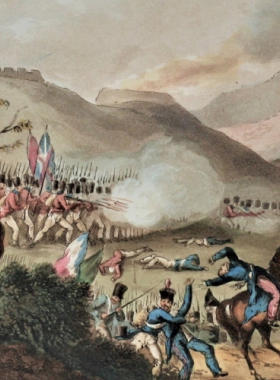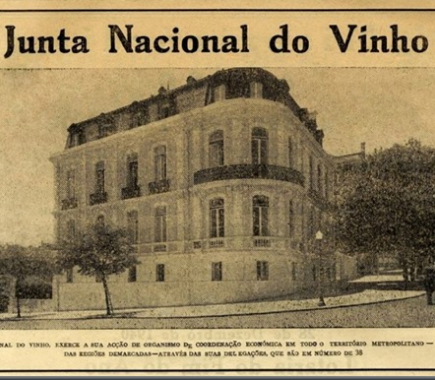-

Arraste para mover
História
History of Portugal
The origin of wines in Portugal seems to date back to around 2000 BC, when the mythical and hypothetical civilisation of Tartessos flourished, using it as its currency of exchange.
-
![.]()
2000 B.C.
2000 B.C. Kingdom of Tartessos to Iberian Celts
Wine, produced from vines planted in the Tejo and Sado valleys, served as a currency of exchange, fostering the culture of the vine and making it an important asset in the culture and life of the people.
![Portugal]()
10th century BC
Phoenicians
7th century BC
Greeks
6th century BC
Celts and Iberians
2nd century BC - Romans
The Romanisation of the Peninsula led to the consolidation of wine production in Portugal, since Rome's development caused consumption to skyrocket, demanding ever greater production that the local vines couldn't handle. It was up to the colonies to meet the demand and guarantee that wine flowed, abundantly, all over the Roman Empire.
![]()
-
![.]()
8th Century
8th century - Arabs until the Christian Reconquest in the 12th century
Between the 8th and 12th centuries, a time marked by Arab influence and a culture that strictly forbade the consumption of fermented beverages, vine growing and wine production were curiously maintained, benefiting from the benevolent and protective spirit with which the Arabs regarded farmers.
![Portugal]()
8th Century
Arabs
12th Century
Christian Reconquest
1143 - Portugal
The foundation of Portugal, in 1143, and the conquest of the whole of Portuguese territory from the Moors, in 1249, allowed the establishment of religious, military and monastic orders, which became active centres of agricultural colonisation. The important role played by wine in religious ceremonies encouraged the growing of vines and wine became a natural part of medieval man's diet.
Slowly, the wines from Portugal gained notoriety, and in the second half of the 14th century wine production went through a phase of great development and exportation.
![]()
-
![.]()
15th Century
15th Century - Discoveries and the conquest of Ceuta
Transported in the caravels, essentially as ballast, the fortified wines would age inside the barrels scattered around the holds of the galleys, where time, heat and the rocking of the sea would perform a small miracle, offering, on the return, a wine of unequalled quality, considered precious and sold at a price of gold. They called it "Roda" or "Torna Viagem" wine and it was with it that the Portuguese started to get to know and work with the ageing of wine.
1415
Conquest of Ceuta
1498
Maritime route to India
1500
Discovery of Brazil
17th Century- Maritime routes
In the mid-16th century, Lisbon was the biggest centre of consumption and distribution of wine in the empire, and Portuguese wine reached the four corners of the world. In the 17th century, a series of works of a geographical nature and travel accounts allow us to understand the historical path of the Portuguese winegrowing areas, the prestige of its wines and the importance of consumption and export volumes.
![Portugal]()
![]()
-
![.]()
18th Century
1703 - Methuen Treaty
In 1703, with the agreement to regulate trade between Portugal and England, established in the Methuen Treaty, Portuguese wine exports experienced a new phase of expansion.
![Portugal]()
1756 - Douro Demarcated Region
On 10 September 1756, by royal charter, the Companhia Geral da Agricultura das Vinhas do Alto Douro was created with the aim of disciplining the production and trade of the region's wines and establishing the demarcation of the region, which did in fact happen.
As in so many other aspects of national life, the Marquis of Pombal exerted a strong influence on the winegrowing sector, establishing a series of protectionist measures aimed in particular at the Alto Douro region and the famous Port Wine.
![]()
-
![.]()
19th Century
1807-10 - French Invasions
The 19th century marked a dark period for winemaking in Portugal. Initially by the devastation caused by the oidium disease, followed by the phylloxera plague, which initially appeared in the Douro region in 1856, quickly spreading to the whole country, devastating most of the winegrowing regions.
![Portugal]()
1850
Vineyard diseases
1867
Phylloxera
1874 - Great London Exhibition
Once this threat was overcome, Portuguese wine production started to recover and Portuguese wines returned to the limelight at the great London Exhibition of 1874.
Colares was the only exception, as phylloxera does not develop in the sandy soils where its vines are still cultivated today.
![]()
-
![.]()
1900
1907 - Regulation of the wine sector
At the beginning of the 20th century, the process of officially regulating various other Portuguese appellations of origin began. Madeira, Moscatel de Setúbal, Carcavelos, Dão, Colares and Vinho Verde joined Port Wine and the table wines of the Douro.
1910
Implantation of the Republic
![Portugal]()
1926 - Estado Novo
With the Estado Novo (1926-1974), the Federação dos Vinicultores do Centro e Sul de Portugal was created (1933), whose main role was to help regulate the market.
1937 - National Wine Board
It was succeeded in 1937 by the National Wine Board, a wider body with a strong cooperative component, whose intervention took into account the balance between supply and outlets, the evolution of production and the storage of surpluses in years of high production, so as to guarantee compensation in years of scarcity.
![Portugal]()
1942
Launch of Matheus Rosé
1950s-60s
Cooperative Wineries
1974
25th April
![]()
-
![.]()
1986
1986 - Portugal joins the EEC and the Vine and Wine Institute
In 1986 the National Wine Board was replaced by the Vine and Wine Institute, a body adapted to the structures imposed by the new market policy resulting from Portugal's accession to the European Economic Community.
![Portugal]()
ViniPortugal founded in 1996
ViniPortugal, the Interprofessional Organisation of Portuguese Wine, was founded in 1996 and recognised by order of the Ministry of Agriculture.
1986 to 2000 - Designation of origin
The concept of "Denomination of Origin" is then harmonised with community legislation and "Regional Wine", i.e. table wines with geographical indication, is regulated, reinforcing the quality policy for Portuguese wines.
-
![.]()
Recent
2000 to 2010
The Regional Winegrowing Commissions (private, interprofessional associations governed by statutes) were then set up. By taking on responsibility for defending the Appellations of Origin and Geographical Indications and applying and monitoring compliance with existing regulations, they play a fundamental role in increasing and developing the quality and prestige of Portuguese wines. 31 Appellations of Origin and 12 Geographical Indications are currently recognised and protected in Portugal.
Support from Europe was essential for the viability of countless modern vineyards and wineries that boosted winemaking activity; at the same time, a new generation of producers and oenologists was being prepared at Portuguese universities in the areas of viticulture and oenology, allowing them to acquire further experience in the winemaking world.
Portugal still has several cooperatives, some of which are excellent, there are also large successful companies, but recent decades have seen the growth of a large number of small and independent producers, some of whom previously delivered their grapes to cooperatives and who have since gone on to produce their own wines.Some vineyards are new and modern, with grape varieties selected according to current markets; others are decades or century-old vineyards, with various old varieties, with low yields but high aromatic concentration.![In 2010, the Vinhos de Portugal / Wines of Portugal brand was created, which is a collective brand and a means of communicating Portuguese wines around the world.]()
In 2010, the Vinhos de Portugal / Wines of Portugal brand was created, which is a collective brand and a means of communicating Portuguese wines around the world.
Wines of Portugal uses cookies to enhance your online experience. By using this website you agree to our cookies policy.













